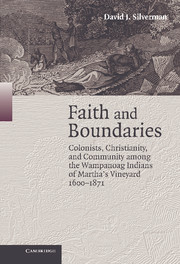 Faith and Boundaries
Faith and Boundaries Book contents
- Frontmatter
- Contents
- Maps, Tables, and Figures
- Abbreviations
- Preface: Do Good Walls Make Good Neighbors?
- Introduction: Epenow's Lessons
- 1 “Here Comes the Englishman”
- 2 To Become All Things to All Men
- 3 The Lord Tests the Righteous
- 4 Deposing the Sachem to Defend the Sachemship
- 5 Leading Values
- 6 The Costs of Debt
- 7 “Newcomers and Strangers”
- Conclusion: Fencing In, Fencing Out
- Appendix A The Population of Martha's Vineyard
- Appendix B A Cross-Comparison of Indian Race Descriptions
- Index
4 - Deposing the Sachem to Defend the Sachemship
Published online by Cambridge University Press: 17 December 2010
- Frontmatter
- Contents
- Maps, Tables, and Figures
- Abbreviations
- Preface: Do Good Walls Make Good Neighbors?
- Introduction: Epenow's Lessons
- 1 “Here Comes the Englishman”
- 2 To Become All Things to All Men
- 3 The Lord Tests the Righteous
- 4 Deposing the Sachem to Defend the Sachemship
- 5 Leading Values
- 6 The Costs of Debt
- 7 “Newcomers and Strangers”
- Conclusion: Fencing In, Fencing Out
- Appendix A The Population of Martha's Vineyard
- Appendix B A Cross-Comparison of Indian Race Descriptions
- Index
Summary
Vineyard colonists engrossed Wampanoag land with particular zeal after King Philip's War, spurred on by the new balance of power, the death of Thomas Mayhew Sr., and a rise in Indian-hating, but the Takemmy Indians were supposed to be immune to such pressure. In 1669, Mayhew and the sachem Keteanummin had guaranteed them a mile-square reserve called Christiantown in perpetuity and veto power over future land sales elsewhere in the sachemship. However, the latter clause was rarely honored and with every passing season the Wampanoags lost hunting grounds, fishing stations, and places for gathering wild plants to English expansion. Fears leftover from the war had persuaded the Indians to tolerate this encroachment, but by 1695 they had reached their limits. Recently a settler had constructed an “English-style house” within Christiantown on a tract known as “the Red Ground.” If the praying Indians allowed this breach to stand, their village border was sure to erode and wash away. It was time for; action.
In June, four Wampanoag men went to expel the intruder, but they found only a young boy who sensibly refused to unlatch the door. No matter; Isaac Ompany climbed onto the roof, leapt “down the oven[']s mouth,” and then, with the boy looking on crying, emptied the dwelling of all its contents. Afterwards, Ompany claimed the house as his own while the other Indians pulled down crops and a fence in the nearby field.
- Type
- Chapter
- Information
- Faith and BoundariesColonists, Christianity, and Community among the Wampanoag Indians of Martha's Vineyard, 1600–1871, pp. 121 - 156Publisher: Cambridge University PressPrint publication year: 2005
